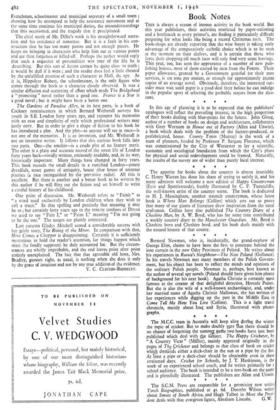Book Notes
THIS is always a season of intense activity in the book world. But this year publishers, their activities restricted by paper-rationing and a bottleneck at every printer's, are finding it particularly difficult preparing for what looks like being a record Christmas rush. The book-shops are already reporting that the wise buyer is taking early advantage of the comparatively catholic choice which is to be seen at the moment on their shelves, and it is certain that those who leave their shopping till much later will only find very scant leavings. This year, too, has seen the appearance of a number of new pub- lishing houses, most of them started by men from the Forces. Their paper allowance, granted by a Government grateful for their past services, is six tons per annum, or enough for approximately zo,000 copies of an average novel. Obviously, therefore, the interested out- sider must wait until paper is a good deal freer before he can indulge in the popular sport of selecting the probable stayers from the also- rans.
* * * * In this age of planning it is to be expected that the publishers' catalogues will reflect the prevailing interest, in the high proportion of their books dealing with blue-prints for the future. John Gloag, author of a number of books on design and architecture, collaborates with Grey Wornum in House out of Factory (Allen and Unwin), a book which deals with the problem of the factory-produced, or prefabricated, house. County Town (Murray) is the work of a team of planners, headed by Professor P. Sargant Florence, which was commissioned by the City of Worcester to lay a scientific, economic and sociological foundation from which the City's plans for physical and social redevelopment could be framed. Naturally, the results of the survey are of wider than purely local interest.
* * * * The appetite for books about the country is almost insatiable. C. Henry Warren has done his share of trying to satisfy it, and his many admirers will welcome a new edition of Happy Countryman (Eyre and Spottiswoode), freshly illustrated by C. F. Tunnicliffe, the well-known artist of the country scene. The book is dedicated to H. J. Massingham, another staunch countryman, whose latest book is Where Man Belongs (Collins) which sets out to prove that many of our giants of literature drew inspiration from the rural 'craftsmen. Collins have also published The Country Diary of a Cheshire Man, by A. W. Boyd, who has for some time contributed a weekly country diary to the Manchester Guardian. Mr. Boyd is Cheshire born and Cheshire bred, and his book deals mainly with the natural history of that county.
• * *
Bernard Newman, who is, incidentally, the grand-nephew of George Eliot, claims to have been the first to penetrate behind the iron curtain in the new Oder Provinces of Poland. He writes about his experiences in Russia's Neighbour—The New Poland (Gollancz). In his travels Newman met many members of the Polish Govern- ment, but his object has been to reflect the minds and opinions of the ordinary Polish people. Newman is, perhaps, best known as the author of several spy novels (Poland should have given him plenty of background for his next book). Agatha Christie is certainly most famous as the creator of that delightful detective, Hercule Poirot. But she is also the wife of a well-known archaeologist, and, under her married name of Agatha Christie Mallowan, she has written of her experiences while digging up the past in the Middle East in Come Tell Me How You Live (Collins). This is a light travel chronicle, mainly about Iraq and Syria, illustrated with photo- graphs.
* * * *
The M.C.C. team in Australia will keep alive cluting the winter the topic of cricket. But to make doubly sy.re that there should be no chance of forgetting the summer genie two books have just been published which deal withthe aject. The Happy Cricketer, by " A Country Vicar " (Wier), mainly appeared originally in the pages of The Cricketer and belongs to that class of book on cricket which d6(s either a deck-chair in the sun or a pipe by the fire. At re--st a pipe or a deck-chair should be obtainable even in these straitened days. Cricket for Schools, by J. T. Hankinson is the work of an experienced school coach, and he writes primarily for a school audience. The book is intended to be a text-book on the game and is plentifully illustrated. The publishers are Allen and Unwin.
* * The S.C.M. Press are responsible for a promising new series, Torch Biographies, published at 4s. 6d. Dorothy Wilson writes about Smuts of South Africa, and Hugh Talbot in Meet the Presi- dent deals with that evergreen figure, Abraham Lincoln. G. W.


































 Previous page
Previous page